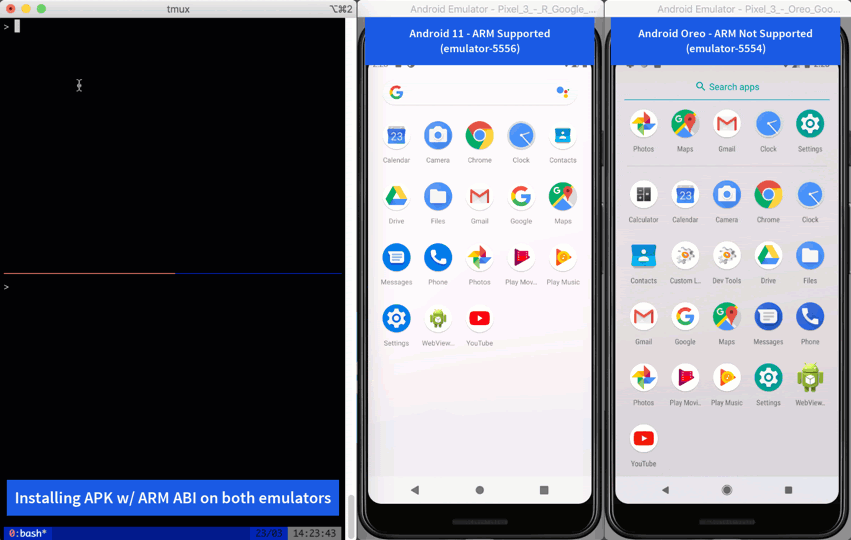

- #ANDROID EMULATORS FOR MAC DONT WORK HOW TO#
- #ANDROID EMULATORS FOR MAC DONT WORK WINDOWS 10#
- #ANDROID EMULATORS FOR MAC DONT WORK OFFLINE#
- #ANDROID EMULATORS FOR MAC DONT WORK TV#
- #ANDROID EMULATORS FOR MAC DONT WORK WINDOWS#
#ANDROID EMULATORS FOR MAC DONT WORK OFFLINE#
“ emulator-5554 – Device is currently in the offline state“Īgain, I tried many solution suggestions (started with emulator internet connection), but this is the one smart man that shone a light on me (you know the beam of light coming from the sky accompanied by the enlightening sound of choir chanting “aaaaaaaaa”): Replace the AVD system images with the r02 images: I went to “Troubleshoot Device connections”, and got the message: The emulator seemed offline, even though it was running.
#ANDROID EMULATORS FOR MAC DONT WORK HOW TO#
Visit the official sites for details on how to install and use these emulators.The emulator was working, but it could not connect to the internet, and when I wanted to debug an app on it, it looked as though Android Studio does not see the emulator is running. avdmanager listĪn applicable option is to use third-party emulators (like GenyMotion). To list all the downloaded system images use the list command.

If you do not specify a path, the AVD will be created in ~/.android/avd/. p path: Path to the location where the directory for this AVD's files will be created. Use this option if you need to overwrite an existing AVD with a new AVD using the same name. For example, -c path/to/sdcard/ or -c 1000M. $ avdmanager create avd -n name -k "sdk_id" [-c : The path to the SD card image for this AVD or the size of a new SD card image to create for this AVD, in KB or MB, denoted with K or M. For more information about the avdmanager and how to use it to create AVDs, see the official avdmanager documentation.Ĭommand syntax to create new AVD $ cd $ANDROID_HOME/tools/bin The avdmanager is provided in the Android SDK Tools package (25.3.0 and higher) and is located in /tools/bin/. The avdmanager is a tool that allows you to create and manage Android Virtual Devices (AVDs) from the command line. Creating Android Virtual Device via command line tool Note: If your top-level "Tools" menu does not include the "Android" option (a common issue in versions >3.0.0), follow the instructions in this StackOverflow answer to add this to the toolbar and enable the AVD Manager. Creating Android Virtual Device via Android Studioįollow the official documentation on Creating and Managing Virtual Devices, where the process of downloading, setting up, and using Android Emulators via Android studio is covered. Once the emulator is started, leave it open to avoid the initial load time the next time you need to deploy an Android application. There are some interface and performance issues, but BlueStack is an overall stable program that allows.
#ANDROID EMULATORS FOR MAC DONT WORK TV#
Its most notable feature is the ability to cast to your TV so that you can play mobile games on a big screen. Its free, easy to set up, and available for both major operating systems. It can work with only 1GB RAM, but it is always recommended to have 4GB RAM in your system. BlueStacks is one of the most popular Android emulators.

#ANDROID EMULATORS FOR MAC DONT WORK WINDOWS#
It is a significant attraction for people looking for a lightweight emulator because it is compatible with Windows 7/8/8.1/10 (32-bit/64-bit). As a recommendation and to avoid timing issues, start the emulator before executing other CLI commands. 1 Droid4x (8.3 MB) The first one on the list we have Droid4x (8.3 MB), which is best known for its lightweight. Tip: Sometimes emulators take longer to start. │ 2 │ bullhead │ Android │ 00d3e1311075c66f │ Device │ Connected │
#ANDROID EMULATORS FOR MAC DONT WORK WINDOWS 10#
KoPlayer is another best android emulator in this list, and it is best to play an Android game on Windows 10 Laptop. │ 1 │ sdk_google_phone_x86_64 │ Android │ emulator-5554 │ Emulator │ Connected │ It works with all versions of Windows and is said to be the lightweight android emulator. │ # │ Device Name │ Platform │ Device Identifier │ Type │ Status │ More information about this command could be found in the tns device article.Įxample output from tns device $ tns device In NativeScript, we can use all Android emulators that are connected and recognized by the tns device command. Apart from using real Android devices, a viable option is to download, install and use an Android emulator.


 0 kommentar(er)
0 kommentar(er)
